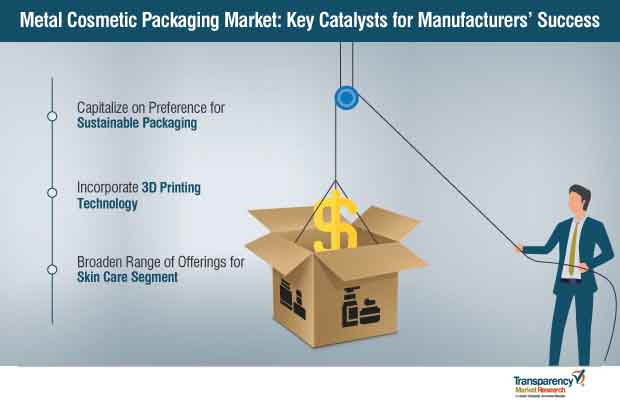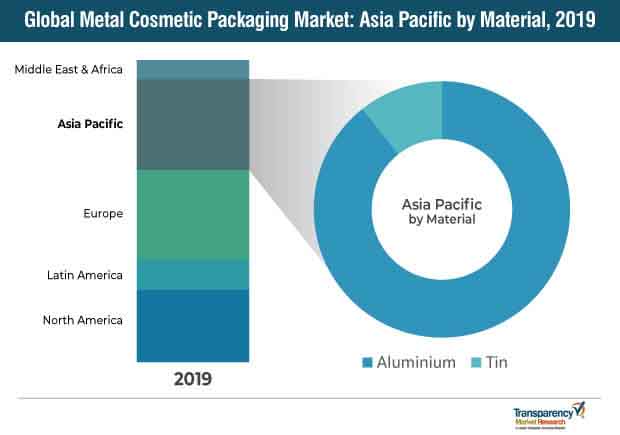
Consumer care and personal care product providers continue to cash in on the growing opportunities due to the increasing consumption of consumer care products. Changing lifestyles have led to the adoption of new hygiene routines, such as the use of anti-aging products, driving the sales of beauty and personal care packaging, worldwide. The increasing trend for flexibility and affordability has led to the consumption of smaller pack sizes. While cosmetic demand propels, manufacturers are not only focused towards offering effective cosmetics, but are also emphasizing the need to offer convenient product usage and dispensing, driving design innovation.
Emphasis on driving consumer engagement is further likely to support innovation in cosmetic packaging. Moreover, consumer distaste for plastic on account of the environmental hazards followed by its use is shifting attention towards metal cosmetic packaging. Transparency Market Research (TMR) recently published an extensive study on the metal cosmetic packaging market, with a positive perspective of the industry, owing to the aforementioned factors. The study unveils the key elements driving the industry’s growth, while elaborating on the developments witnessed across the metal cosmetic packaging market.

Planning to lay down future strategy? Perfect your plan with our report brochure here
Unwrapping the Success Timeline
Through ancient times, metal packaging has been in seen in the form of gold and silver boxes, along with strong alloys. 1200 A.C. marked the start of the production of tin sheets in Bohemia. Following this, the beginning of the 14th century experienced the commencement of the use of tin containers for food packaging. Over the course of time, metal packaging containers found their application in several end-use sectors, including cosmetic packaging. Around 1966, enactment of the Fair Packaging and Labeling Act (FPLA) gained ground, which required all consumer products in interstate commerce to be informatively and honestly labeled, with the FDA imposing regulations on food, drugs, cosmetics, and medical devices. The use of metal packaging for cosmetics has surged phenomenally over the recent past, as cosmetic product manufacturers recognized the need to reduce the use of plastic in packaging.
Changing consumption patterns and the requirements of cosmetic product manufacturers led to an evolutionary growth in the metal cosmetic packaging market. According to TMR’s study, the metal cosmetic packaging market is expected to witness sales revenue of ~ US$ 4.4 Bn, registering a CAGR of ~4% in 2019. The rising demand from commercial setups and the growing popularity of packaging as a key differentiating factor for cosmetics are expected to fuel the growth of the metal cosmetics market.
Impact of Undercurrents on Metal Cosmetic Packaging Landscape
Decorative Techniques to Boost Appearance
Brand owners are focusing more on improved visuals for metal cosmetic packaging to help clients gain a competitive edge. Many have embraced digital printing that offers opportunities for developing eye-catching colors, and bold and striking visuals. Technological developments in digital printing continue to foster these efforts, bringing key changes across the metal cosmetic packaging landscape.
Sustainability Emerging as a Decisive Factor for Purchase
Most metal cosmetic packaging manufacturers are focusing on providing sustainable and eco-friendly packaging for cosmetics, which has been one of the major factors affecting consumer purchase decisions regarding cosmetics. Recyclable packaging solutions such as metal packaging are therefore gaining immense popularity among cosmetic product manufacturers.
Lightweighting Trend to Spur Innovation
Lightweighting has been a fast-growing trend within the metal cosmetics packaging industry over the past decade. This trend enables packaging manufacturers and cosmetic brand owners to reduce their environmental footprint, thereby improving their sustainability credentials, while also reducing overall costs. By developing more lightweight metal cosmetic packaging, less material is utilized, whilst reducing the energy consumption for distribution and logistic purposes.

Want to know the obstructions to your company’s growth in future? Request a PDF sample here
Manufacturers’ Strategies Catalyzing Business Growth
Elevate Consumer Appeal by Using 3D Printing
The aspect of product differentiation is gaining center stage for cosmetic product providers in an attempt to build a brand image, consequently creating the need for improved and differentiated packaging solutions. Players in the metal cosmetic packaging market are adopting various technologies such as 3D printing technology to develop appealing metal cosmetic packaging. 3D printing is the new trend that is being adopted by manufacturers to enhance product look and attract cosmetic consumers. This is expected to contribute to the rise in the sales of metal cosmetic packaging solutions.
Invest in Producing Packaging for Skin Care Products
Application of metal packaging in skin care and hair care products is expected to boost the business of market players. Rising skin care awareness coupled with falling cosmetic prices is offering promising opportunities for packaging providers. Owing to this, investments centered towards producing packaging for skin care products would prove profitable.
Although significant developments are cited towards improving products, certain aspects are expected to hinder the progress of the market. Volatile raw material prices and fluctuating demand and supply of raw materials are likely to restrain the overall global metal cosmetic packaging market.
Scrutinizing the Competitive Landscape
In 2018, AptarGroup, Inc. announced the acquisition of Reboul, a renowned and innovative leader in prestige beauty packaging. With this strategic acquisition, Aptar improved its capabilities, including high speed metal stamping, deep metal drawing, and differentiated lipstick mechanism design and production. The transaction positioned Aptar to capitalize on the growth in the color cosmetics market, and strengthened its ability to serve customers in the fragrance and skin care markets.
In 2019, Crown Holdings Inc. launched a new metal packaging-a new round-to-square-shaped tin that would find its application in the packaging of luxury products, as well as biscuits, confectionery, tea, and cosmetics. Produced by using a 100% recyclable material, this product fits the consumer requirement for convenience.
With merely 10-15% of the global metal cosmetic packaging market held by leading market players, and the remaining 80-85% controlled by other companies in 2018, the market remains fragmented in nature. Leading players of metal cosmetic packaging are adopting key strategies to enhance the quality of the product. Companies are constantly showing innovations in the design and functionality of their products in the beauty segment. Expansion in the global market remains a go-to strategy to increase their consumer base, which is incorporated by means of collaborations and acquisitions.
Read Our Latest Press Release:
- https://www.prnewswire.com/news-releases/power-management-integrated-circuits-market-predicted-to-be-valued-at-us56-48-bn-by-2026–applications-in-highly-lucrative-automotive-consumer-electronics-sectors-evident-of-monumental-growth–tmr-301262055.html
- https://www.prnewswire.com/news-releases/rising-trend-of-remote-work-due-to-covid-19-pandemic-will-breathe-fresh-air-of-growth-across-the-endpoint-detection-and-response-edr-market-says-tmr-301266666.html





